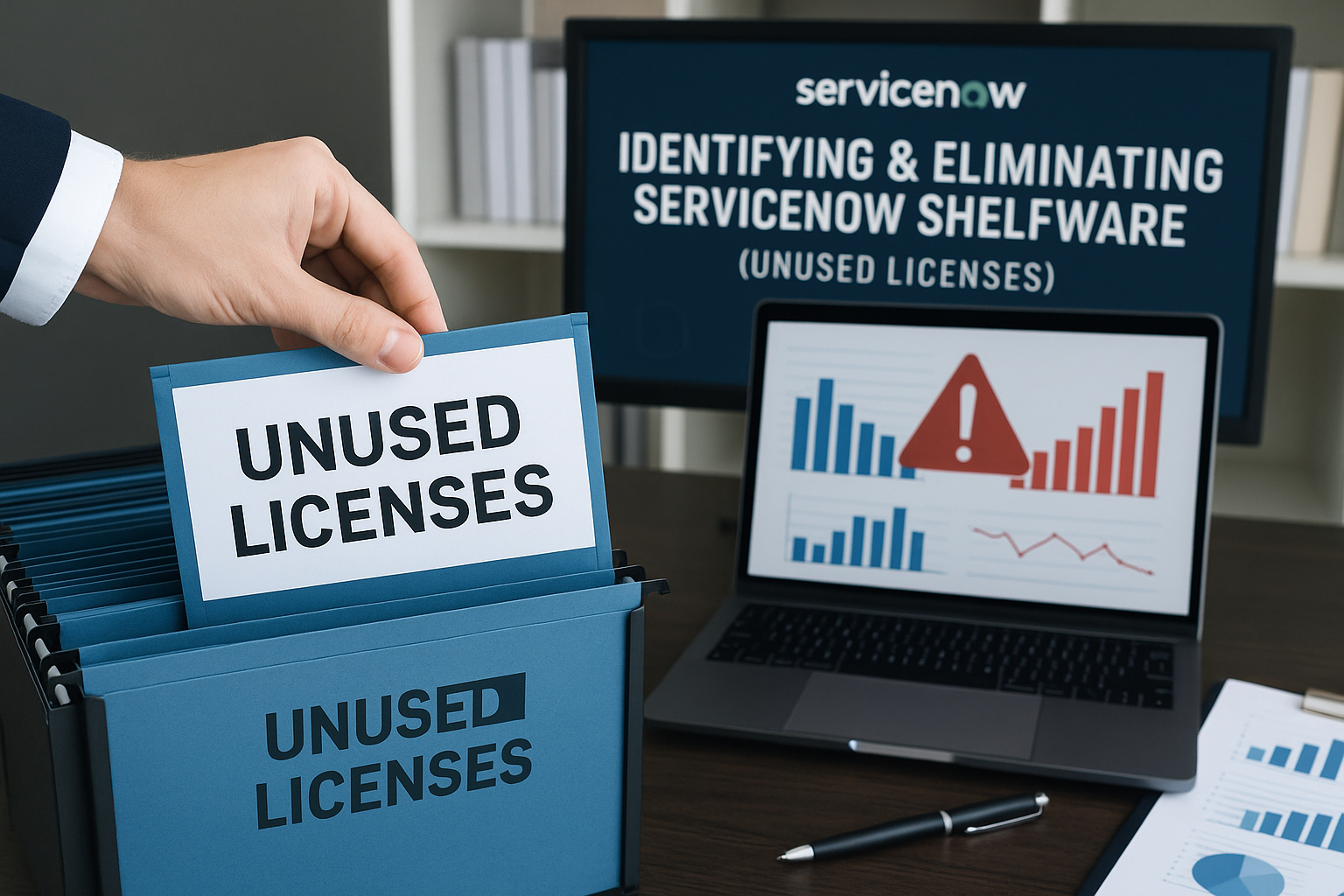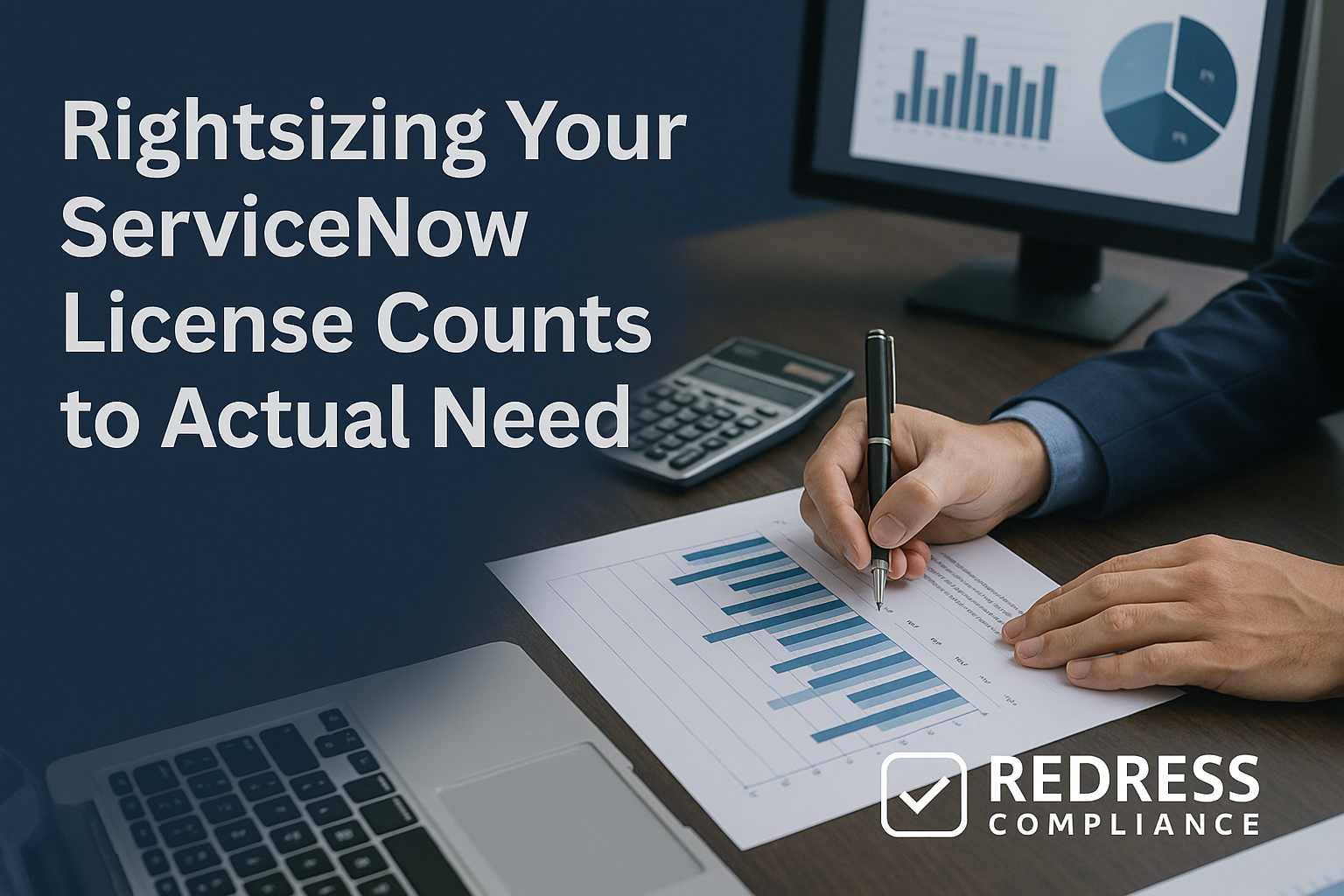Every organization using ServiceNow eventually ends up with some shelfware – paid-for licenses or modules that sit unused. It may feel like wasted money, but shelfware isn’t a failure – it’s an opportunity.
You can reclaim value from unused licenses by turning that shelfware into negotiation leverage. Think of every unused license as a bargaining chip, not just dead weight you have to carry.
A global bank discovered that users never activated 20% of its ServiceNow ITSM licenses. At renewal time, rather than writing that shelfware off as a loss, they negotiated a $1.1 million credit toward new HR Service Delivery (HRSD) modules. This example shows the power of approaching shelfware strategically – it becomes negotiation currency rather than a sunk cost.
Read our comprehensive guide, ServiceNow License Optimization: Rightsizing, Recycling & Shelfware Cuts.
ServiceNow Shelfware Negotiation: 5 Steps to Reclaim Value from Unused Licenses
Step 1 – Quantify Your Shelfware Value
The first step is to audit your ServiceNow usage and find exactly what licenses or modules are going unused. Pull data from your usage reports or analytics dashboards – look at last login dates, inactive user accounts, and modules that were paid for but never fully implemented. Common areas to check include:
- User licenses: Fulfiller or ITSM Pro seats assigned to people who never log in.
- Modules: Products like IT Asset Management or HRSD that were purchased but not deployed.
- Capacity: Entitlements such as Virtual Agent sessions, node licenses, or transaction tokens where your usage is far below the allotment.
Once you’ve inventoried the unused entitlements, translate each into monetary terms. Put a real dollar figure next to every piece of shelfware – this is money you spent but didn’t realize value from, and it’s what you aim to reclaim or repurpose.
Next, build your “giveback inventory” – a list of all shelfware items with their counts and dollar values. Note when they were purchased and when they expire, since older or soon-to-expire items are especially worth addressing. Rank your shelfware by total value or by relevance to your current plans. This focuses you on the biggest opportunities to recover value.
Checklist – Shelfware Audit Outputs:
- Count of unused licenses/modules: How many of each entitlement are sitting idle?
- Dollar value of unused licenses: Licenses × unit price for each item.
- Original purchase info: Purchase date and term/expiry for each software item.
- Potential reallocation uses: Ideas for where this unused spend could be applied (other modules or needs).
Armed with this data, you know exactly how much value is sitting idle. You’re ready to put those dollars to work in your renewal discussion.
Pro Tip: Don’t walk into renewal talks with just usage stats – walk in with a dollar value on your shelfware. Quantifying unused licenses in monetary terms gives you a concrete bargaining chip.
Using Usage Analytics to Drive License Optimization Decisions
Step 2 – Position Shelfware as a Negotiation Asset
With your shelfware inventory in hand, set the narrative for negotiation. Frame the shelfware not as your company’s mistake, but as evidence that the deal’s scope was misaligned with your actual needs. You bought more than you used – now you simply need to rebalance that value in the future.
For example, instead of admitting “We overbought,” you can say: “Our analysis shows we didn’t use the full scope that was sold to us. We need to rebalance that value in the renewal.” This shifts the focus to solving the issue together, rather than laying blame.
Decide what form of giveback you want. There are a few ways to reclaim the value of shelfware:
- Credit: Apply the value of the unused licenses as a credit toward new ServiceNow products or upgrades you actually need.
- License swap: Exchange the unused licenses or modules for others that will be used. (For example, trade unused ITAM licenses for HRSD or CSM licenses where you have demand.)
- Price reduction: Use shelfware as justification for a lower renewal price. If you paid for 100 and only used 80, you expect to pay less going forward.
The key is to present your ask as a fair realignment of value. You’re not asking for a refund of past spend – you’re asking to carry that unused value forward in a way that benefits both sides.
Pro Tip: Always frame your giveback request as a realignment, not a clawback. Emphasize that you want to invest those unused dollars into something useful. Vendors respond better when the discussion is about reallocating value to future needs, instead of pointing fingers over past overspend.
Step 3 – Negotiate Givebacks Strategically
When it’s time to negotiate, remember that timing is critical. Introduce your shelfware findings early in the renewal process – ideally, a couple of months before the renewal date or before pricing proposals are set. If you bring it up at the last minute, it may be dismissed as a budget plea. By raising it early and calmly, you show that adjusting for shelfware is a standard part of your planning.
Use your shelfware analysis to anchor the discussion. For instance, you might say: “We found about 15% of our licenses went unused. We’ll be reducing our renewal scope by that amount, or we’ll need an equivalent cost adjustment.” This makes it clear you will not renew everything as-is and that you expect pricing to reflect actual usage.
Keep the conversation solution-focused by asking the vendor to help solve the shelfware problem. Instead of accusing anyone of overselling, make it a collaborative effort. You could propose options like:
- “We’d like a credit for this shelfware applied toward our next module purchase.”
- “Can we swap these unused ITAM licenses for additional HRSD seats where we have a need?”
- “We expect a shelfware adjustment in the renewal pricing to account for the value we didn’t use.”
Suggesting concrete giveback options (credit, swap, discount) guides the negotiation toward practical outcomes. It encourages the ServiceNow rep to think in terms of solutions they can offer.
Checklist – Giveback Negotiation Gameplan:
- Raise it early: Bring up your shelfware analysis well before final negotiations heat up.
- Quantify the gap: Clearly state how much you paid for but didn’t use (in licenses and dollars).
- Reset the baseline: Make clear that renewing everything as-is is off the table, given the underuse.
- Propose a remedy: Request specific relief (credits, swaps, or a discount) to realign the contract’s value.
- Stay collaborative: Treat this as a joint problem to solve going forward, not a gripe about the past.
Pro Tip: Bring data to the table early, not complaints at the eleventh hour. Timing drives credibility. An early, fact-based shelfware discussion carries weight.
Step 4 – Document the Outcome Properly
As you reach an agreement on givebacks, ensure everything is captured in writing. If ServiceNow agrees to a concession – whether it’s a credit, a license swap, or a discount – insist it appears explicitly in the renewal order form or contract amendment.
Likewise, if you negotiate a swap (trading one product for another), the contract should clearly list the licenses removed and the new licenses added in exchange. Don’t rely on informal assurances or side emails; get all adjustments into the formal documents.
Internally, keep a record of what giveback you received so you can verify the benefit and ensure those new licenses are actually used (preventing new shelfware down the road).
Pro Tip: If it’s not in the contract, it doesn’t count. Never rely on handshake promises – get every giveback and adjustment in writing. Paperwork is your proof and leverage later on.
Step 5 – Prevent Future Shelfware
The ideal scenario is to avoid accumulating a pile of shelfware again. Some overage is inevitable as needs change, but you can build in safeguards to minimize waste. One powerful tactic is negotiating a true-down clause in your agreement. Essentially, a built-in license giveback program that lets you reduce license counts (and costs) at specified intervals based on actual usage, meaning any excess gets trimmed without penalty, and would-be shelfware becomes automatic savings.
Also commit to continuous license monitoring. Don’t wait until the end of a multi-year term to find out 20% of your licenses went unused. Use ServiceNow’s dashboards or Software Asset Management tools to track usage regularly (for instance, quarterly). If a module isn’t being adopted as expected, take action – boost its user adoption, consider phasing it out, or plan to true-down those licenses at the next renewal. Integrate these usage insights into your yearly planning so that right-sizing licenses becomes routine.
Mini-Scenario: After negotiating a $700,000 credit for unused HRSD licenses, one tech firm also added a shelfware true-down clause to its new contract. Since then, whenever they have excess licenses, they trim them at renewal instead of paying for shelfware. This clause has saved them from overpaying while keeping shelfware from piling up again.
Pro Tip: Push for a true-down option in your contract. A true-down clause turns future shelfware into automatic savings – a safety net so you’re never stuck paying for unused licenses.
Read about our ServiceNow Optimization Services.


